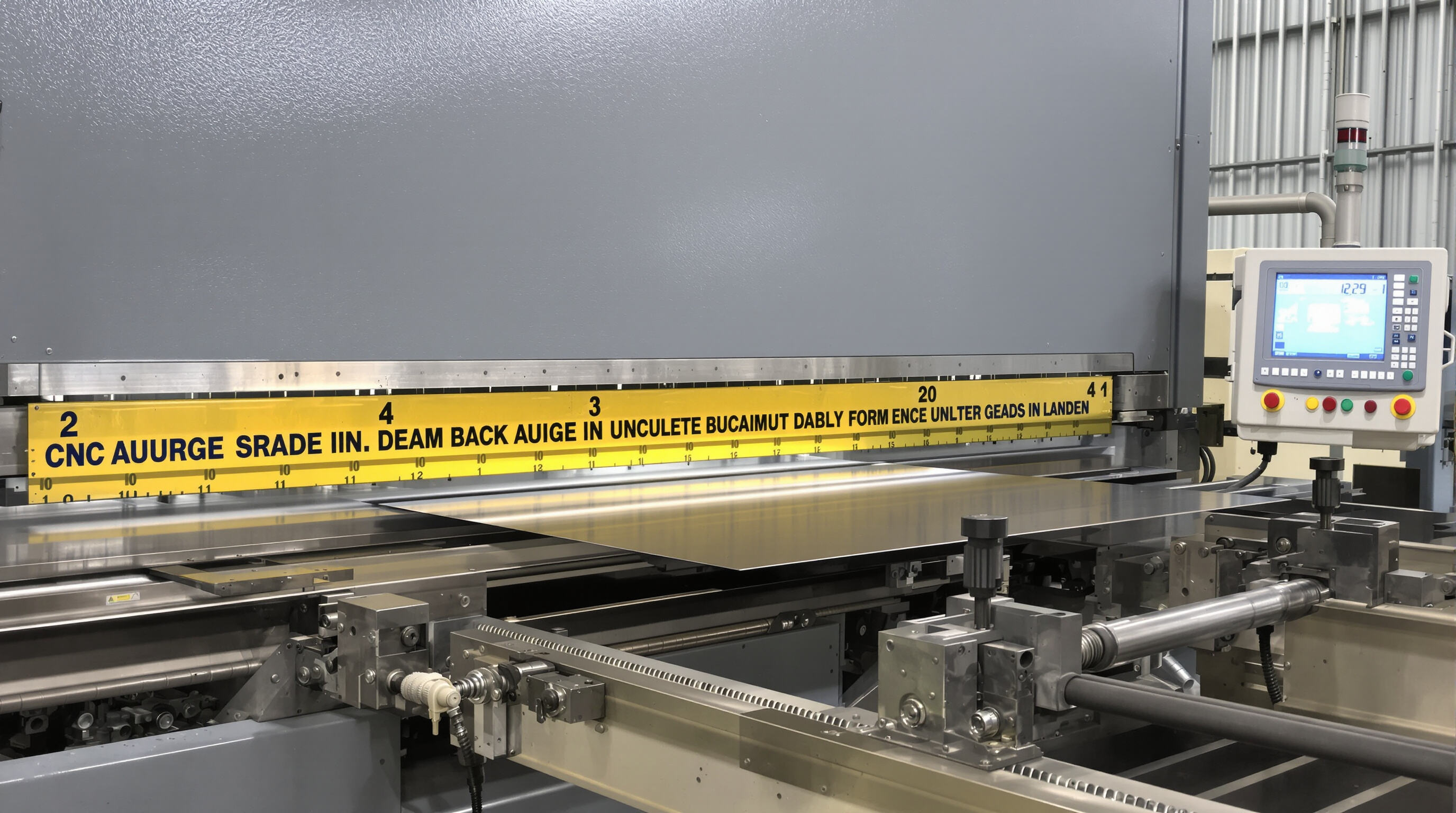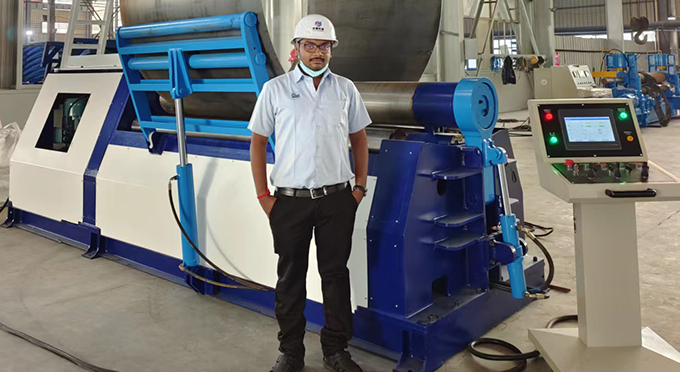How Guillotine Shearing Machines Work: Mechanism and Key Components

The guillotine mechanism explained: Applying force for clean, precise cuts
A guillotine shear works by moving an upper blade down vertically against a stationary lower blade to slice through metal sheets. These machines can produce as much as 4000 pounds per square inch of cutting power thanks to their hydraulic, mechanical or pneumatic systems. What makes them effective is that the blade has this very sharp angle between about half a degree and two and a half degrees. This angled approach focuses all that force on just a small section of the material. As a result, there are fewer burrs left behind after cutting. The machine maintains pretty tight tolerances too around plus or minus 0.1 millimeters even when working with sheets as thick as 25mm. This means the cuts come out nice and clean without any unwanted deformations.
Core components: Blades, back gauge, hold-down clamps, and control systems
Four critical subsystems govern performance:
- Blades: Hardened tungsten-steel upper and lower blades maintain sharpness for 60,000–80,000 cuts between sharpenings
- Back gauge: CNC-guided stops position sheets with 0.05 mm accuracy
- Hold-down clamps: Hydraulic clamps apply 10–25 tons of pressure to prevent slippage
- Control systems: Touchscreen interfaces allow real-time adjustments to blade gap, shear angle, and stroke speed
Types of guillotine shears: Mechanical, hydraulic, pneumatic, and CNC
| Type | Force Source | Max Thickness | Precision | Industrial Use Case |
|---|---|---|---|---|
| Mechanical | Flywheel/Crank | 6 mm | ±0.3 mm | Small workshops, thin sheets |
| Hydraulic | Fluid Pressure | 25 mm | ±0.1 mm | Heavy fabrication, stainless |
| Pneumatic | Compressed Air | 10 mm | ±0.2 mm | Rapid cutting, aluminum |
| CNC-Integrated | Servo Motors | 20 mm | ±0.05 mm | Aerospace, automated lines |
Hydraulic systems dominate 72% of industrial applications (IMTS 2024) due to consistent force across material grades. CNC models incorporate AI-driven predictive blade wear compensation, reducing scrap rates by 18% compared to manual systems.
Hydraulic Guillotine Shearing Machines: Operation and Industrial Advantages
How Hydraulic Systems Enable Powerful and Controlled Shearing
These hydraulic guillotine shears are capable of delivering cutting forces that go well beyond 300 tons, all while maintaining an impressive precision level of plus or minus just 0.1 mm. What makes them stand out? They have dual pistons which allow for what we call graded pressure application. According to the Industrial Machinery Report from 2023, this design actually results in about 30% better force consistency when compared with traditional mechanical shears. For those working with materials like stainless steel or aluminum, operators get control over blade speeds ranging between 10 and 25 mm per second. This adjustment capability helps prevent unwanted warping during cuts. Another big advantage comes from their fluid based power system that does away with clutches altogether. This setup cuts down on those sudden force spikes by roughly 80% when looking at how they perform versus older pendulum type models on the market today.
Advantages of Hydraulic Guillotine Shearing Machines
| Feature | Operational Impact |
|---|---|
| Adjustable Shear Angle | Reduces sheet distortion by 40% in 12mm+ materials |
| Four-Sided Blades | Doubles service life through rotational usage |
| Oil-Cooled Cylinders | Enables 14-hour continuous cutting cycles |
These machines achieve 25% lower energy consumption via variable-displacement pumps that match power output to cutting demands. With 60% fewer moving parts than mechanical systems, maintenance costs are reduced by 45% over five years.
High Efficiency and Productivity in Industrial Sheet Metal Cutting
In one automotive parts plant, they found that their hydraulic guillotine shears could handle about 550 galvanized steel sheets every hour, which is roughly 35 percent quicker than what their old pneumatic machines managed. The programmable back gauges come pretty close to spot on measurements too, within just 0.05 millimeters accuracy. And those fast 0.8 second cycles really make a difference when it comes down to processing whole batches, cutting down time by around 22 minutes each run. Another big plus? Those four sided blades save money over the year, bringing tooling expenses down by nearly 18%. Plus there's that hydraulic overload protection system that keeps things running smoothly even after all these years. Most plants report their frames lasting well past 15 years in tough industrial settings thanks to this feature.
Precision and Automation: CNC Integration in Modern Guillotine Shears

Automation and CNC Integration in Shearing Machines
When CNC technology gets integrated into guillotine shears, it basically turns these machines into highly accurate systems. The automation handles things like where the blade goes, how much force is applied, and even moves materials around automatically. These machines now have servo driven back gauges working together with hydraulic controls so they can make consistent cuts within about plus or minus 0.1 mm over and over again through thousands of operations. According to Industrial Cutting Quarterly from last year, this setup cuts down on those pesky manual measurement mistakes by roughly 73%. That makes a big difference for anyone dealing with sheet metal work, particularly when working with tougher materials like aluminum or stainless steel that might be as thick as 25 mm. Just think about all the time saved not having to double check measurements manually anymore.
Enhancing Precision with Programmable Back Gauges and Digital Controls
Programmable back gauges use laser-guided systems to adjust positioning in 0.01 mm increments. When paired with force-sensing hydraulic cylinders, they automatically compensate for blade wear and material springback. A 2023 study found CNC-integrated models achieve 98.6% cut consistency in aerospace-grade titanium processing, outperforming manual operation by 22%.
Smart Factories and the Rise of Connected, Data-Driven Shearing Equipment
Industry 4.0 compatibility enables CNC guillotine shears to integrate with ERP systems and predictive maintenance platforms. Key advancements include:
- Vibration sensors detecting blade misalignment 40% earlier than manual inspections
- IoT-enabled lubrication systems reducing downtime by 31%
- Cloud-based cutting templates slashing setup times for custom orders
Manual vs. CNC-Operated Guillotine Shears: Performance and Suitability for SMEs
CNC machines really shine when it comes to producing large volumes, typically handling over 1,000 sheets per day. But interestingly enough, around two thirds of smaller manufacturing operations continue to rely on good old manual shears for their low volume work, anything below about 50 pieces. Retrofitting existing equipment with CNC capabilities usually runs somewhere between twenty eight thousand and forty five thousand dollars, which is quite a chunk of change for businesses that don't have steady production demands throughout the year. That's why many shop owners hesitate before making such investments. On the bright side though, there are now hybrid systems available that operate in semi automatic mode, allowing manufacturers to get some of the benefits of automation without completely sacrificing the flexibility needed for custom orders while still maintaining reasonable batch processing speeds.
Industrial Applications of Guillotine Shearing Machines
Applications in Metalworking, Automotive, Construction, and Aerospace
Guillotine shears play a vital role across various sectors that deal with large volumes of sheet metal work. The automotive industry depends heavily on these machines to slice through body panels and chassis parts with near-perfect accuracy down to the millimeter mark. For construction companies working on major projects, guillotines handle structural steel plates as thick as 25mm when preparing materials for roof structures and support beams. In aerospace applications, engineers turn to these powerful tools to cut and shape both titanium and aluminum sheets used in aircraft fuselages and wings. Given how even small errors can compromise flight safety, maintaining tight tolerances becomes absolutely crucial in this field.
High-Tolerance Production Environments and Precision Cutting Demands
Industries like aerospace and medical device manufacturing require cuts within 0.2 mm tolerances. Hydraulic guillotine shears meet these demands through adjustable blade clearances and force control. For instance, manufacturers of electrical enclosures cut stainless steel without burrs, eliminating post-processing and reducing material waste by 18% (Ponemon 2023).
Case Study: Aerospace Component Preparation Using CNC-Integrated Shears
A leading aerospace manufacturer reduced component rejection rates by 37% after adopting CNC-equipped guillotine shears. Laser-guided alignment and programmable back gauges enabled precise trimming of composite materials for engine housings. Complex cutting patterns are now executed in under 90 seconds—60% faster than manual methods—while maintaining ±0.1 mm positional accuracy.
How to Choose the Right Guillotine Shearing Machine for Your Needs
Key selection factors: Capacity, material type, thickness, and precision
The whole process of picking out the correct cutting machine really begins by looking at what kind of production work needs doing. When it comes to cutting capacity, there's quite a difference between what different machines can handle. Hydraulic systems generally manage sheets up to around 25 mm thick, making them suitable for heavier duty jobs. Mechanical models on the other hand work better with thinner materials, typically anything below 6 mm in thickness. What material we're dealing with makes all the difference when selecting blades too. Hardened steel blades stand up well against tough stuff like stainless steel without getting damaged easily. For softer metals such as aluminum, blades need sharper angles so they don't bend or warp the material during cutting. Precision requirements vary across industries as well. Aerospace manufacturing demands extremely tight tolerances around plus or minus 0.1 mm, while most regular fabrication shops find that plus or minus 0.5 mm works just fine for their day to day operations.
Matching machine specifications to your sheet metal cutting requirements
High-volume operations benefit from CNC-integrated hydraulic shears, which reduce setup time by 40% (Fabrication Quarterly, 2023) and automate repetitive tasks. SMEs handling smaller batches may prefer mechanical or pneumatic models for cost efficiency. Consider scalability—modular designs allow upgrades like programmable back gauges as precision demands grow.
Blade clearance and angle adjustments for optimal cut quality
Proper blade configuration prevents warping and burr formation. For 3 mm mild steel, a 0.5 mm clearance ensures clean edges; 5 mm aluminum requires a 0.3 mm gap. Shear angles between 0.5°–2.5° optimize force distribution—incorrect settings increase energy consumption by 15% (Manufacturing Efficiency Review, 2023). Regular calibration using thickness gauges maintains consistent performance across materials.
FAQ Section
What are guillotine shearing machines used for?
Guillotine shearing machines are used to cut sheet metal with precision, making them essential in industries such as automotive, construction, and aerospace.
How does a hydraulic guillotine shear differ from a mechanical shear?
Hydraulic shears use fluid pressure to deliver consistent force, allowing for more precise cuts and greater material thickness handling compared to mechanical shears which typically use a flywheel or crank system.
Why integrate CNC technology into guillotine shears?
CNC integration automates operations, improving precision and efficiency by reducing manual measurement errors and streamlining cutting processes.
What factors should be considered when choosing a guillotine shearing machine?
Consider the capacity, material type, thickness, precision needs, and the scalability for future upgrades when selecting a guillotine shearing machine.
Table of Contents
- How Guillotine Shearing Machines Work: Mechanism and Key Components
- Hydraulic Guillotine Shearing Machines: Operation and Industrial Advantages
- Precision and Automation: CNC Integration in Modern Guillotine Shears
- Industrial Applications of Guillotine Shearing Machines
- How to Choose the Right Guillotine Shearing Machine for Your Needs
- FAQ Section




